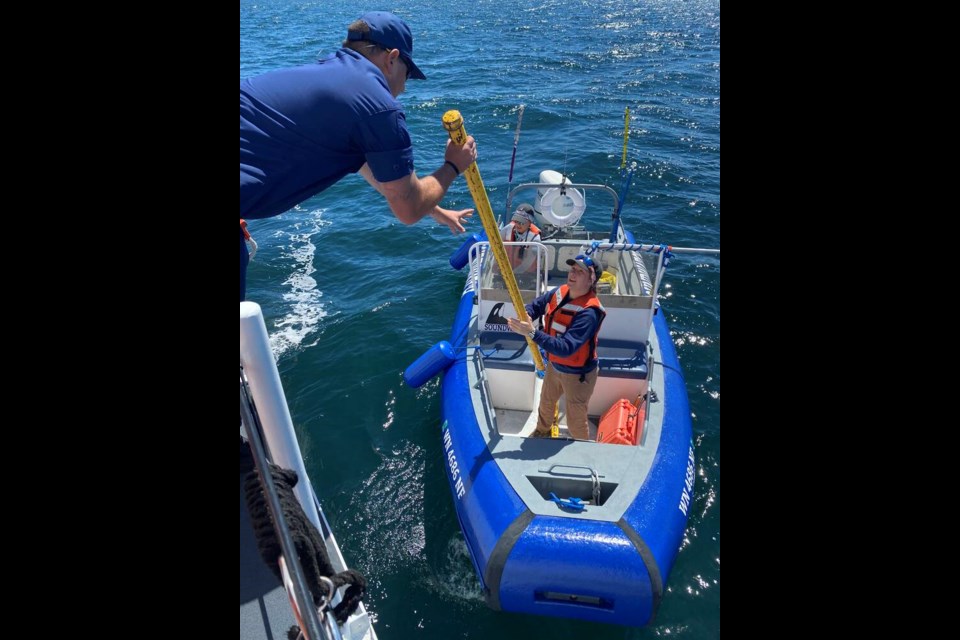The oil sheen from a sunken fishing boat appears to have completely dissipated from an area of U.S. waters east of Victoria, and the Canadian Coast Guard confirmed no oil or diesel has reached Canadian waters.
Concerns remain, however, for the health of marine and mammal life in the area of western San Juan Island, where the 15-metre Aleutian Isle went down Saturday with an estimated 9,800 litres of fuel.
The vessel now lies in 60 metres of water near San Juan Island in Haro Strait, about 25 kilometres east of Victoria, and the depth is complicating efforts to assess the wreck and pump out remaining fuel.
As of Wednesday afternoon, about 3,800 feet of absorbent boom had been placed throughout the affected area, south to Kanaka Bay and north to the tip of Henry Island. The booms will remain as a precautionary measure, said the U.S. Coast Guard.
A statement from the U.S. Department of Ecology said no oil residue has been found on the island and measures are being used to deter whales from venturing near the wreck, which is in a key feeding ground for the endangered southern resident orcas.
Cindy Hansen, education and advocacy co-ordinator for the Orca Network said trials are under way with acoustic deterrence methods in Haro Strait. It involves Washington Department of Fish and Wildlife, National Marine Fisheries Service and some of the whale research vessels which are dipping long metal pipes into the ocean and banging on them with hammers to annoy whales.
One large seine net that floated free of the fishing boat was recovered Tuesday and divers also pulled up several panels of a second net that was floating in about 30 metres of water.
The depth of the Aleutian Isle is complicating efforts to examine it before the remaining fuel can be drained or the ship can be salvaged, and officials say there is no timeline for any of that work.
“This poses additional hazards for divers while they work as they must use specialized gas mixtures and use a decompression chamber upon returning to the surface,” the U.S. Coast Guard said. “The increased depth also limits the amount of time divers can stay on scene with the vessel. These factors combined with the significant currents in the area have necessitated diving operations to be limited to periods in and near slack water.”
The U.S. Coast Guard planned to deploy a remote operated vehicle on Wednesday to help get a clear picture of the state of the Aleutian Isle.
Amid all the response, a U.S. salmon fishery opened Wednesday with a wide-arc closure around the spill site.
“We would encourage fisherman to avoid catching fish in areas where sheens are observed,” said Dave Byers of the U.S. Department of Ecology. “Thankfully, with the dissipation of all visible sheening today, there should be no impacts to salmon fishing.”
On the Canadian side, coast guard officials said Wednesday that no fuel or sheens have entered Canadian waters since the vessel sank, but spill response teams are ready to act if the situation changes.
The Department of Fisheries and Oceans’ Marine Mammal Unit is monitoring for the southern resident killer whales with hydrophone and sonogram, but as of Tuesday night none had been detected at the Point Renfrew, Sheringham, Gulf Islands or Northern Salish Sea hydrophone stations.
The National Aerial Surveillance Program, operated by Transport Canada, is providing regular overflights of the area.
The Orca Network, Soundwatch and other conservation groups are keeping watch on the southern resident orcas, Bigg’s orcas and whales in the area. The southern resident pods, numbering just 74 animals, were last seen Sunday leaving the area just south of the sinking and heading to the open Pacific.
Hansen said there have been no other cetacean sightings within the immediate area of the spill since it occurred. She said there has been a minke whale spotted at Salmon Bank since Monday, as well as humpbacks and Bigg’s orcas, but not in Haro Strait where the spill response is taking place.



